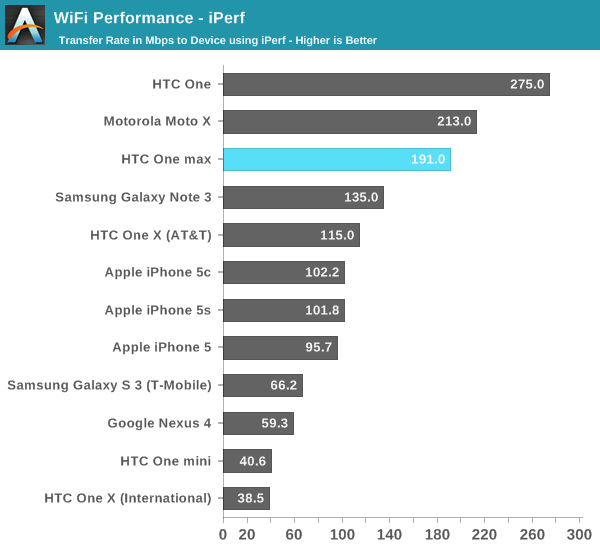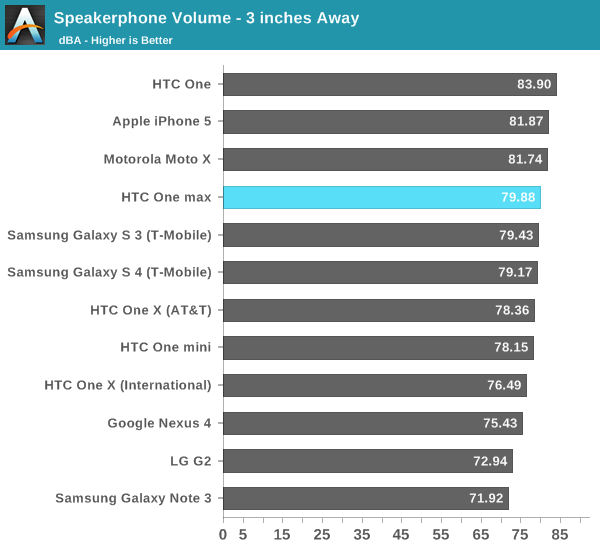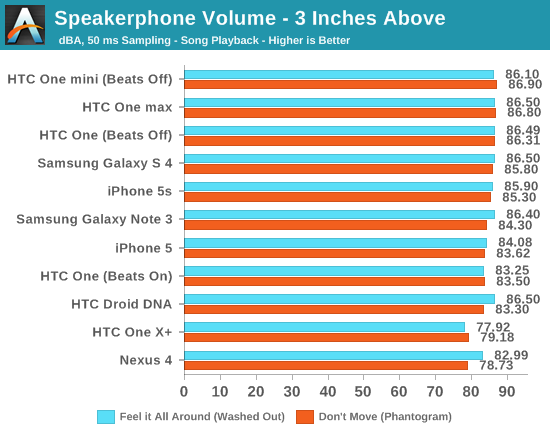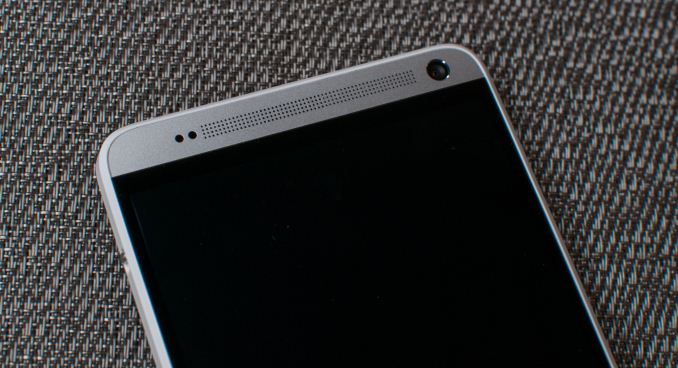HTC One max Review - It's Huge
by Brian Klug on October 28, 2013 10:00 AM EST- Posted in
- Smartphones
- HTC
- Mobile
- One
- Snapdragon 600
- Android 4.3
- One max
Cellular
Cellular on the One max is pretty much the same story as the One, and another shared bullet point. The top and bottom metal cutouts are still the radiative surfaces of the antenna, and there’s still transmit and receive diversity as well to mitigate any unwarranted antenna detuning from holding the device. The unit I was sampled has LTE banding for EMEA (Europe, Middle East, and Africa), but there’s appropriate banding for Asia, Sprint (a tri-mode device with 800/1900 MHz and TDD-LTE on 2600 MHz) and Verizon (700 MHz and AWS), according to the HTC specs page.
The baseband inside the One max is again shared with the One (Qualcomm’s 2nd generation multimode LTE MDM9x15 family), although the One max does have a bit more band support for the USA LTE on Sprint and Verizon, so the front ends are different.
WiFi
Interestingly enough with the One max we see HTC going to Qualcomm Atheros for the WLAN and BT combo, best I can tell this is the WCN3680 which is probably a bit cheaper to include than the BCM4335 we saw in the One. It’s still a single spatial stream 802.11ac capable part, meaning a PHY rate of up to 433 Mbps if you’re in the right channel conditions with 80 MHz channels on 5 GHz. The WCN3680 combo is the 802.11ac successor to WCN3660 which we saw in a number of phones last generation, and is accelerated by the SoC. WCN3680 also does BT 4.0, and FM Rx/Tx if applicable.

To test throughput on the One max I used iPerf the same way I have for a while now. Subjectively there are no complaints from me about WLAN connectivity on the One max, no random dropouts or issues, and Sense 5.5 thankfully still includes the WiFi frequency band manual selection option.
I saw the WCN3680 solution inside Moto X already, it’s interesting to see it in the One max. I believe the One mini uses its 802.11n cousin, WCN3660 as well, probably again for cost reasons.
Speakerphone
Although Beats is gone since that partnership has ended as of the One max, the device still seems to retain everything that made it sound great. There are still the larger-than-typical speaker chambers, big speaker grilles on the top and bottom, stereo sound, and importantly the TFA9887 speaker amplifier and protection part from NXP. In addition there’s still the TPA6185 headphone amplifier as well.
Beats always seemed to be an audio compressor that ran on the DSP, ostensibly through the Hexagon DSP access program or something, and that’s what’s absent on the One max. There’s no toggle under settings for enabling or disabling it, nor the Beats branding, but to be honest I almost always disabled Beats on the One anyways since it was a fair amount louder with it disabled. What made the One great was all the hardware behind the speakers, not so much the software compressor.


The One max goes plenty loud just like the original One. I went ahead and added the One mini and 5s to the chart too, just to check whether things have changed much, in addition to the Galaxy S 4 and Note 3. The One max basically performs like the One with Beats turned off, which isn’t a surprise since it isn’t there anymore. There’s also no detectable saturation, and the One line remains the only device that doesn’t sound tinny or rattly with overemphasized highs and lacking mids. I suspect the A weighting I selected a while ago for measuring might be a contributing factor as well. Either way you’re not going to be wanting for more loudness on the One max, and the inclusion of front firing stereo speakers makes for a completely different listening experience.












197 Comments
View All Comments
steven75 - Thursday, October 31, 2013 - link
You realize that Google itself dropped SD support from Android, right? Something Brian has mentioned numerous times, yet here you are again making the claim that "Apple is perfection" like a true troll.PC Perv - Tuesday, October 29, 2013 - link
And you have no issue with OEMs charging extra $100 per each incremental storage size? Sure you get free phones and lots other perks so perhaps that is why you are so understanding of the OEMs. But have you thought about this nonsense from consumers' point of view?I am guessing no. Every other pages are filled with the author's worry and concern about OEM's margins or market share. Why do you care? Why should I care about their cost savings? This has been the trend of this site for a long time. Unbelievable amount of corporate favoritism plus unapologetic ignorance on users.
rabidkevin - Tuesday, October 29, 2013 - link
I'm sorry, but you make zero sense.sherlockwing - Monday, October 28, 2013 - link
You can purchase 13000 mAh External battery packs for $37 weighing 0.9lbs, a far better option than a extra battery for GS4.Dentons - Monday, October 28, 2013 - link
And I can purchase 4, 3100 mAh Galaxy Note II batteries for about half that. All 4 together weigh just .47 pounds (54 grams each, 0.11 lbs each)All together, the four of them take up less space than any external battery pack I've ever seen. If I'm only going to be gone overnight, I need only take 1 spare. With all 4 and the battery in the phone, I can usually operate for a solid week without recharging once.
A user replaceable battery is also a hedge against the planned obsolescence of built-in batteries. Batteries wear out, the have a very finite number of cycles. A battery that will no longer hold a charge is one of the leading reasons consumers buy new phones.
User replaceable batteries and micorSD are as much about reducing consumer costs as anything else. It isn't difficult to see why reviewers awash in a torrent of new, free, phones aren't particularly enamored in these features. They don't use phones for 2+ years. They don't pay for the larger memory models. They don't wear out batteries.
chizow - Monday, October 28, 2013 - link
Agree with pretty much everything you've written in all of your replies. The fact that this comment section is dominated by comments disagreeing with Brian's position on microSD should say something, but I doubt it will have any lasting impact on his opinion of the matter.It's a good thing device makers seem to be going in the opposite direction, all I see now are devices adding the functionality.
superflex - Tuesday, October 29, 2013 - link
Alinsky tactics.Attack the messenger when the message is not what you want to hear.
Grow up.
Gadgety - Monday, October 28, 2013 - link
It's funny - when reading negative comments on HTC phones these days I can't help but think it's Samsung sponsored comments (BTW I have a Samsung phone).ddriver - Monday, October 28, 2013 - link
I wish samsung paid me :) Dunno about paid comments, but there sure are a lot of paid reviews, and I don't mean paid by samsung,I think negative comments towards this device are well justified, it goes beyond the reasonable size and hardware is ... previous gen at best. Given all this space to cram components in, this phone should have been much, much better. Alas, htc is no samsung that produces everything and no apple to exploit fanatical brand loyalty, so the only way to keep profit margins decent while keeping the price "reasonable" is to offer cheaper and slightly out-of-date hardware.
Sm0kes - Monday, October 28, 2013 - link
He's not talking about the validity of the criticism, but instead the relentless "shill" type comments that constantly bring up Samsung in every discussion.FYI - Samsung was being investigated by the Taiwan's FTC back in April for paying student "shills" to slam HTC and advocate for Samsung on tech review sites. Google for the link. It's pretty clear Samsung's marketing is pretty scummy.